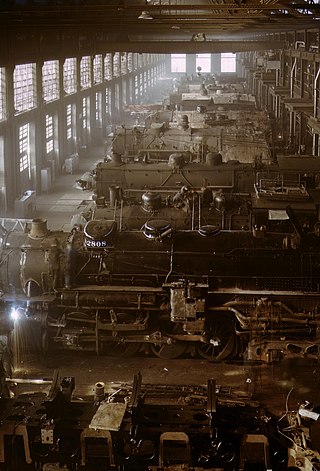Related Research Articles

The Industrial Revolution, also known as the First Industrial Revolution, was a period of global transition of human economy towards more widespread, efficient and stable manufacturing processes that succeeded the Agricultural Revolution, starting from Great Britain, continental Europe, and the United States, that occurred during the period from around 1760 to about 1820–1840. This transition included going from hand production methods to machines; new chemical manufacturing and iron production processes; the increasing use of water power and steam power; the development of machine tools; and the rise of the mechanized factory system. Output greatly increased, and the result was an unprecedented rise in population and the rate of population growth. The textile industry was the first to use modern production methods, and textiles became the dominant industry in terms of employment, value of output, and capital invested.
A trade union or labor union, often simply referred to as a union, is an organisation of workers whose purpose is to maintain or improve the conditions of their employment, such as attaining better wages and benefits, improving working conditions, improving safety standards, establishing complaint procedures, developing rules governing status of employees and protecting and increasing the bargaining power of workers.

Syndicalism is a revolutionary current within the labor movement that, through industrial unionism, seeks to unionize workers according to industry and advance their demands through strikes, with the eventual goal of gaining control over the means of production and the economy at large through social ownership. Developed in French labor unions during the late 19th century, syndicalist movements were most predominant amongst the socialist movement during the interwar period that preceded the outbreak of World War II.

The United East India Company was a chartered company established on 20 March 1602 by the States General of the Netherlands amalgamating existing companies into the first joint-stock company in the world, granting it a 21-year monopoly to carry out trade activities in Asia. Shares in the company could be bought by any resident of the United Provinces and then subsequently bought and sold in open-air secondary markets. It is sometimes considered to have been the first multinational corporation. It was a powerful company, possessing quasi-governmental powers, including the ability to wage war, imprison and execute convicts, negotiate treaties, strike its own coins, and establish colonies.

Child labour is the exploitation of children through any form of work that deprives them of their childhood, interferes with their ability to attend regular school, or is mentally, physically, socially and morally harmful. Such exploitation is prohibited by legislation worldwide, although these laws do not consider all work by children as child labour; exceptions include work by child artists, family duties, supervised training, and some forms of work undertaken by Amish children, as well as by Indigenous children in the Americas.

The British Agricultural Revolution, or Second Agricultural Revolution, was an unprecedented increase in agricultural production in Britain arising from increases in labor and land productivity between the mid-17th and late 19th centuries. Agricultural output grew faster than the population over the hundred-year period ending in 1770, and thereafter productivity remained among the highest in the world. This increase in the food supply contributed to the rapid growth of population in England and Wales, from 5.5 million in 1700 to over 9 million by 1801, though domestic production gave way increasingly to food imports in the 19th century as the population more than tripled to over 35 million.

In sociology, an industrial society is a society driven by the use of technology and machinery to enable mass production, supporting a large population with a high capacity for division of labour. Such a structure developed in the Western world in the period of time following the Industrial Revolution, and replaced the agrarian societies of the pre-modern, pre-industrial age. Industrial societies are generally mass societies, and may be succeeded by an information society. They are often contrasted with traditional societies.

Human history is the narrative of humankind's past. Modern humans evolved in Africa around 300,000 years ago and initially lived as hunter-gatherers. They migrated out of Africa during the Last Glacial Period and had populated most of the Earth by the time the Ice Age ended 12,000 years ago.
The putting-out system is a means of subcontracting work, like a tailor. Historically, it was also known as the workshop system and the domestic system. In putting-out, work is contracted by a central agent to subcontractors who complete the project via remote work. It was used in the English and American textile industries, in shoemaking, lock-making trades, and making parts for small firearms from the Industrial Revolution until the mid-19th century. After the invention of the sewing machine in 1846, the system lingered on for the making of ready-made men's clothing.

The Great Divergence or European miracle is the socioeconomic shift in which the Western world overcame pre-modern growth constraints and emerged during the 19th century as the most powerful and wealthy world civilizations, eclipsing previously dominant or comparable civilizations from the Middle East and Asia such as the Ottoman Empire, Mughal India, Safavid Iran, Qing China, and Tokugawa Japan, among others.
Proto-industrialization is the regional development, alongside commercial agriculture, of rural handicraft production for external markets. The term was introduced in the early 1970s by economic historians who argued that such developments in parts of Europe between the 16th and 19th centuries created the social and economic conditions that led to the Industrial Revolution. Later researchers suggested that similar conditions had arisen in other parts of the world.
The consumer revolution refers to the period from approximately 1600 to 1750 in England in which there was a marked increase in the consumption and variety of luxury goods and products by individuals from different economic and social backgrounds. The consumer revolution marked a departure from the traditional mode of life that was dominated by frugality and scarcity to one of increasingly mass consumption in society.

The economic history of the Netherlands (1500–1815) is the history of an economy that scholar Jan de Vries calls the first "modern" economy. It covers the Netherlands as the Habsburg Netherlands, through the era of the Dutch Republic, the Batavian Republic and the Kingdom of Holland.
Life in Great Britain during the Industrial Revolution shifted from an agrarian based society to an urban, industrialised society. New social and technological ideas were developed, such as the factory system and the steam engine. Work became more regimented, disciplined, and moved outside the home with large segments of the rural population migrating to the cities.

The financial history of the Dutch Republic involves the interrelated development of financial institutions in the Dutch Republic. The rapid economic development of the country after the Dutch Revolt in the years 1585–1620 accompanied by an equally rapid accumulation of a large fund of savings, created the need to invest those savings profitably. The Dutch financial sector, both in its public and private components, came to provide a wide range of modern investment products beside the possibility of (re-)investment in trade and industry, and in infrastructure projects. Such products were the public bonds, floated by the Dutch governments on a national, provincial, and municipal level; acceptance credit and commission trade; marine and other insurance products; and shares of publicly traded companies like the Dutch East India Company (VOC), and their derivatives. Institutions like the Amsterdam stock exchange, the Bank of Amsterdam, and the merchant bankers helped to mediate this investment. In the course of time the invested capital stock generated its own income stream that caused the capital stock to assume enormous proportions. As by the end of the 17th century structural problems in the Dutch economy precluded profitable investment of this capital in domestic Dutch sectors, the stream of investments was redirected more and more to investment abroad, both in sovereign debt and foreign stocks, bonds and infrastructure. The Netherlands came to dominate the international capital market up to the crises of the end of the 18th century that caused the demise of the Dutch Republic.

This article covers the Economic history of Europe from about 1000 AD to the present. For the context, see History of Europe.
Katherine Jane Humphries, CBE FBA, is a Fellow of All Souls College, University of Oxford with the Title of Distinction of professor of economic history. Her research interest has been in economic growth and development and the industrial revolution. She is the former president of the Economic History Society and the current vice-president of the Economic History Association.
A general strike is a strike action in which participants cease all economic activity, such as working, to strengthen the bargaining position of a trade union or achieve a common social or political goal. They are organised by large coalitions of political, social, and labour organizations and may also include rallies, marches, boycotts, civil disobedience, non-payment of taxes, and other forms of direct or indirect action. Additionally, general strikes might exclude care workers, such as teachers, doctors, and nurses.
The proletariat is the social class of wage-earners, those members of a society whose only possession of significant economic value is their labour power. A member of such a class is a proletarian or a proletaire. Marxist philosophy regards the proletariat under conditions of capitalism as an exploited class - forced to accept meager wages in return for operating the means of production, which belong to the class of business owners, the bourgeoisie.

Akira Hayami was an emeritus professor of Keio University and the first to introduce historical demography in Japan. Professor Hayami is also famous for coining the concept called "Industrious Revolution",which points out the socio-economic change from capital-intensive to labor-intensive one.
References
- ↑ Clark, Gregory; Van Der Werf, Ysbrand (1998). "Work in Progress? The Industrious Revolution". The Journal of Economic History. 58 (3): 830–843. doi:10.1017/S0022050700021197. JSTOR 2566627. S2CID 154711188.
- 1 2 3 4 De Vries, Jan (2008). The industrious revolution: consumer behavior and the household economy, 1650 to the present. New York: Cambridge University Press. ISBN 978-0-521-89502-6.
- 1 2 De Vries, Jan (1994). "The Industrial Revolution and the Industrious Revolution". Journal of Economic History. 54 (2): 249–270. doi:10.1017/S0022050700014467. JSTOR 2123912. S2CID 154990961.
- ↑ Pomeranz, Kenneth (2002). "Political Economy and Ecology on the Eve of Industrialization: Europe, China, and the Global Conjuncture". The American Historical Review. 107 (2): 425–446. doi:10.1086/532293. JSTOR 532293.
- ↑ de Vries, Jan (2008). The Industrious Revolution: Consumer Behavior and the Household Economy, 1650 to the Present . Cambridge, MA: Cambridge University Press. pp. 78. ISBN 9780521895026.
- ↑ Arrighi, Giovanni; Hamashita, Takeshi; Selden, Mark (2003). The Resurgence of East Asia: 500, 150 and 50 Year Perspectives. London: Routledge. pp. 83. ISBN 978-0415316361.
- 1 2 De Vries 1994, p. 255.
- ↑ De Vries 1994, p. 256.
- ↑ De Vries 1994, p. 257.
- 1 2 Hayami, Akira (2015). Japan's Industrious Revolution: Economic and Social Transformations in the Early Modern Period. Tokyo: Springer. pp. 95–97. ISBN 9784431551416.
- ↑ Clark & Van Der Werf 1998, p. 839.
- ↑ Clark & Van Der Werf 1998, p. 836.
- ↑ Clark & Van Der Werf 1998, p. 837..
- ↑ Clark & Van Der Werf 1998, p. 835.
- 1 2 Clark & Van Der Werf 1998, p. 834.
- ↑ Allen, R. C.; Weisdorf, J. L. (2011). "Was there an 'industrious revolution' before the industrial revolution? An empirical exercise for England, c. 1300–1830". The Economic History Review. 64 (3): 715–729. doi:10.1111/j.1468-0289.2010.00566.x. ISSN 1468-0289. S2CID 152295393.
- ↑ Humphries, Jane; Weisdorf, Jacob (1 October 2019). "Unreal Wages? Real Income and Economic Growth in England, 1260–1850". The Economic Journal. 129 (623): 2867–2887. doi: 10.1093/ej/uez017 . ISSN 0013-0133.
- 1 2 Wiesner-Hanks, Merry E. (2006). Early Modern Europe, 1450–1789. New York: Cambridge University Press. ISBN 978-0-521-80894-1.
- ↑ Wiesner-Hanks 2006, p. 202.
- ↑ Jardine, Lisa (1996). "Conspicuous Consumption". Worldly Goods: A New History of the Renaissance. New York: Nan A. Talese. pp. 379–424. ISBN 978-0-385-47684-3.
- ↑ Wiesner-Hanks 2006, p. 419.
- ↑ Wiesner-Hanks 2006, p. 418.
- ↑ Wiesner-Hanks 2006, p. 205.
- ↑ De Vries 1994, p. 262.
- ↑ De Vries 1994, pp. 261–62.
- ↑ Ross, Ellen (1993). Love and Toil. Motherhood in Outcast London, 1870-1918. New York: Oxford University Press. ISBN 978-0-19-503957-3.